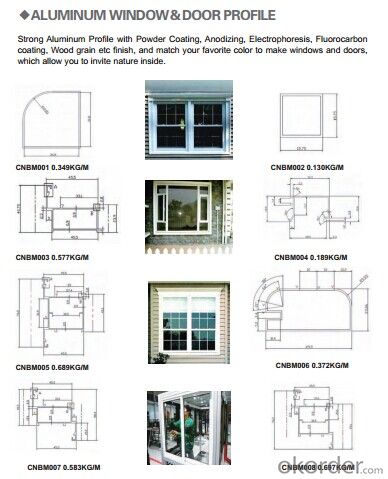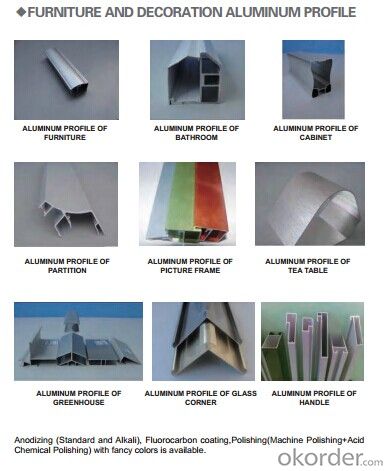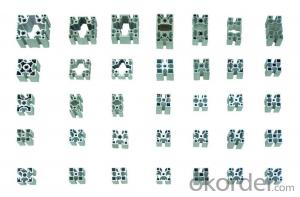Aluminum profile extrusion for led light strips
- Loading Port:
- China Main Port
- Payment Terms:
- TT OR LC
- Min Order Qty:
- -
- Supply Capability:
- -
OKorder Service Pledge
OKorder Financial Service
You Might Also Like
Aluminium is a relatively soft, durable, lightweight, ductileand malleablemetalwith appearance ranging from silvery to dull gray, depending on the surfaceroughness. It is nonmagnetic and does not easily ignite. A fresh film ofaluminium serves as a good reflector (approximately 92%) of visible lightand an excellent reflector (as much as 98%) of medium and far infraredradiation. The yield strength of pure aluminium is 7–11 MPa,while aluminium alloys have yield strengths ranging from200 MPa to 600 MPa. Aluminium has about one-third the densityand stiffness of steel. It is easily machined,cast, drawn and extruded.
Aluminium alloys (or aluminum alloys; see spellingdifferences) are alloysin which aluminium(Al) is the predominant metal. The typical alloying elements are copper, magnesium,manganese,silicon,tin and zinc. There are twoprincipal classifications, namely casting alloys and wrought alloys, both of which are furthersubdivided into the categories heat-treatableand non-heat-treatable. About 85% of aluminium is used for wrought products,for example rolled plate, foils and extrusions.Cast aluminium alloys yield cost-effective products due to the low meltingpoint, although they generally have lower tensile strengthsthan wrought alloys. The most important cast aluminium alloy system is Al–Si,where the high levels of silicon (4.0–13%) contribute to give good castingcharacteristics. Aluminium alloys are widely used in engineering structures andcomponents where light weight or corrosion resistance is required
Features:
Material | Alloy 6063,6061,6005or according to customer’s choice |
Temper | T3, T4, T5, T6 |
Surface | Anodize, electrophoresis, powder coating, PVDF coating, wood grain painting, matted, etc. |
Length | Coating 6.5 meters, Anodizing 6.5 meters, Mill finish 5 meters |
Application | Industrial, electrical equipment(TV set, air conditioner, refrigerator, computer), decoration,construction, transportation |
Custom Made | We can package following with customer's request. |




FAQ:
1. What is the form of payment?
Normally 30% TT, L/C at sight
2. Type of quotation?
FOB, CFR, CIF
3. Port of loading?
Shenzhen/Guangzhou port
4. Delivery time?
15-20 days after client’s deposit
- Q:I'm made of aluminum, and I need profiles every month. Where can I buy the information and let the factory take the initiative to find me?
- Can go to the Alibaba website, China aluminum network, HC network, China manufacturing network, Mark Polo network, business treasureGlobal hardware networkMusic for hundredChinese supplierChalcoChinese aluminum netGlobal economic and trade networkWeb sites such as the world trade network will be fine,
- Q:What are the standard dimensions of aluminum profiles?
- The standard dimensions of aluminum profiles can vary depending on the specific industry and application. However, there are some common standard dimensions that are widely available. In general, aluminum profiles come in a variety of shapes and sizes, including rectangular, square, circular, and custom shapes. The most common dimensions for rectangular aluminum profiles are typically between 1 inch to 6 inches in width and 1/2 inch to 4 inches in height. Square profiles often range from 1 inch to 4 inches in width and height. Circular aluminum profiles, also known as tubes or pipes, are typically available in various outer diameters ranging from 1/4 inch to 8 inches, with wall thicknesses ranging from 1/16 inch to 1/2 inch. It's important to note that these are general standard dimensions and there can be variations depending on the manufacturer and specific requirements of a project. Additionally, custom dimensions can be manufactured to meet unique specifications. When selecting aluminum profiles, it's crucial to consider the intended application and load-bearing requirements to ensure the chosen dimensions can adequately support the intended use.
- Q:Are aluminum profiles resistant to termites and insects?
- Yes, aluminum profiles are highly resistant to termites and insects. Unlike wood, which is susceptible to termite infestations and insect damage, aluminum is a nonporous material that does not provide a food source for these pests. Additionally, aluminum profiles are typically coated with protective finishes, such as powder coating or anodizing, which further enhance their resistance to termites and insects. This makes aluminum profiles a durable and long-lasting option for various applications, such as window frames, door frames, and other construction projects where termite or insect damage is a concern.
- Q:What are the benefits of using aluminum profiles in interior design?
- There are several benefits of using aluminum profiles in interior design. Firstly, aluminum profiles are highly versatile and can be used in a wide range of applications. They can be easily customized and fabricated to fit different design requirements. Whether you are designing a modern, minimalist space or a traditional, ornate interior, aluminum profiles offer a flexible solution. Secondly, aluminum profiles are lightweight yet durable, making them an ideal choice for interior design. They are resistant to corrosion, moisture, and temperature changes, ensuring a long lifespan. This durability also means that aluminum profiles require minimal maintenance, saving both time and money in the long run. Another benefit of using aluminum profiles is their aesthetic appeal. They come in a variety of finishes, colors, and textures, allowing designers to achieve their desired look and feel. Aluminum profiles can be anodized, powder-coated, or polished, giving them a sleek and modern appearance. They can also be designed to mimic other materials, such as wood or stainless steel, while offering the added benefits of aluminum. Additionally, aluminum profiles offer excellent thermal and acoustic insulation properties. They can help regulate temperature and reduce noise levels, creating a more comfortable and peaceful environment. This is especially beneficial in areas where soundproofing or energy efficiency is required, such as offices, hotels, or residential spaces. Lastly, aluminum profiles are eco-friendly and sustainable. Aluminum is a highly recyclable material, and using aluminum profiles in interior design helps reduce waste and minimize environmental impact. Moreover, aluminum profiles can contribute to energy efficiency by allowing natural light to enter a space, reducing the need for artificial lighting during the day. In conclusion, the benefits of using aluminum profiles in interior design are versatility, durability, aesthetic appeal, thermal and acoustic insulation, and sustainability. These qualities make aluminum profiles a popular choice among designers and architects looking to create functional and visually appealing spaces.
- Q:Are aluminum profiles suitable for transportation equipment?
- Yes, aluminum profiles are highly suitable for transportation equipment. Aluminum is lightweight, which helps reduce the overall weight of the equipment, making it more fuel-efficient. Additionally, aluminum is corrosion-resistant, durable, and easily customizable, making it ideal for various transportation applications such as aerospace, automotive, and marine industries.
- Q:What are the different fastening options available for aluminum profiles?
- There are several different fastening options available for aluminum profiles, depending on the specific application and desired functionality. Some common fastening options include: 1. Screws: Using screws is a widely used method to fasten aluminum profiles. They can be easily installed and provide a strong and secure connection. Self-tapping screws are often used, as they create their own threads in the aluminum profile. 2. Bolts and nuts: Bolts and nuts offer another reliable fastening option for aluminum profiles. They provide a strong connection and can be easily tightened or loosened as needed. It is important to select the appropriate bolt and nut size and ensure proper tightening to prevent stripping or loosening of the connection. 3. T-slot nuts: T-slot nuts are designed specifically for T-slot aluminum profiles, which have a groove along the length of the profile. T-slot nuts slide into the groove and can be easily positioned and tightened using a hex key. They provide a versatile and adjustable fastening option, allowing for easy repositioning or modification of the profile. 4. Clamps: Clamps are commonly used to secure aluminum profiles together or attach other components to the profile. They come in various designs, such as corner clamps or angle clamps, and provide a quick and easy way to assemble or disassemble aluminum structures. 5. Adhesives: Adhesives can be used to bond aluminum profiles together, offering a clean and seamless appearance. However, the strength of the bond may vary depending on the adhesive used and the surface preparation. It is essential to select an adhesive specifically designed for aluminum and follow the manufacturer's instructions for proper application. 6. Welding: Welding is a permanent fastening option for aluminum profiles. It involves melting the aluminum material and fusing it together, creating a strong and durable connection. However, welding requires specialized equipment and skills, making it a more complex and time-consuming process. It is important to consider the specific requirements of the application, such as load-bearing capacity, adjustability, or disassembly needs, when choosing the appropriate fastening option for aluminum profiles. Consulting with experts or manufacturers can help in selecting the most suitable fastening method for a particular project.
- Q:What are the water resistance properties of aluminum profiles?
- Aluminum profiles possess excellent water resistance properties. Aluminum itself is inherently resistant to corrosion, and when properly coated or anodized, it becomes even more resistant to water damage. The coating or anodization process creates a protective layer on the surface of the aluminum, which acts as a barrier against water penetration. Aluminum profiles are commonly used in various applications where they are exposed to water, such as windows, doors, and outdoor structures. Their water resistance properties ensure that they can withstand moisture, rain, and humidity without deteriorating or rusting. Furthermore, aluminum profiles have the advantage of being lightweight, which makes them ideal for use in water-related environments such as marine applications. Despite being lightweight, aluminum profiles offer high strength and durability, allowing them to withstand the harsh conditions associated with being in contact with water. In summary, aluminum profiles have excellent water resistance properties due to their natural resistance to corrosion and the protective coatings or anodization applied to their surfaces. This makes them a reliable choice for applications where exposure to water is expected, ensuring long-lasting performance and minimal maintenance requirements.
- Q:Can aluminum profiles be used in medical equipment manufacturing?
- Yes, aluminum profiles can be used in medical equipment manufacturing. Aluminum is a lightweight and durable material that offers various advantages for medical applications. It is corrosion-resistant, which is crucial in medical settings where equipment is often exposed to chemicals and sterilization processes. Aluminum profiles also provide excellent thermal conductivity, allowing for efficient heat dissipation in medical devices. Furthermore, aluminum profiles can be easily customized to meet specific design requirements, allowing for the creation of complex and precise medical equipment. They can be machined, welded, and formed into various shapes and sizes, making them suitable for a wide range of medical applications, such as surgical instruments, imaging equipment, patient beds, and wheelchairs. In addition to its mechanical properties, aluminum is environmentally friendly and recyclable, aligning with the growing sustainability requirements in the medical industry. It is non-toxic and does not release harmful substances, ensuring the safety of patients and healthcare professionals. Overall, aluminum profiles offer numerous benefits for medical equipment manufacturing, including durability, corrosion resistance, thermal conductivity, customization options, and sustainability.
- Q:Can aluminum profiles be used in food-grade applications?
- Indeed, food-grade applications can make use of aluminum profiles. Aluminum, a lightweight and non-toxic metal, is widely utilized in the food industry due to its corrosion resistance. It is commonly employed in the fabrication of various food processing equipment, including conveyor systems, tanks, shelves, and frames. Additionally, aluminum profiles find utility in the construction of cleanrooms and other sanitary environments where food handling and storage take place. Notably, aluminum is easily sanitized and cleaned, making it an appropriate choice for food-grade applications. Nonetheless, it is crucial to ensure that the aluminum profiles employed are specifically designed for food-grade purposes and adhere to the pertinent regulations and standards. This guarantees the safety and quality of the processed or stored food.
- Q:The number of aluminum profiles can be meters or KG. How exactly is it? How do you understand that?
- According to the calculated root.The general material company is used to calculate the weight or root. Few meters.
1. Manufacturer Overview |
|
|---|---|
| Location | |
| Year Established | |
| Annual Output Value | |
| Main Markets | |
| Company Certifications | |
2. Manufacturer Certificates |
|
|---|---|
| a) Certification Name | |
| Range | |
| Reference | |
| Validity Period | |
3. Manufacturer Capability |
|
|---|---|
| a)Trade Capacity | |
| Nearest Port | |
| Export Percentage | |
| No.of Employees in Trade Department | |
| Language Spoken: | |
| b)Factory Information | |
| Factory Size: | |
| No. of Production Lines | |
| Contract Manufacturing | |
| Product Price Range | |
Send your message to us
Aluminum profile extrusion for led light strips
- Loading Port:
- China Main Port
- Payment Terms:
- TT OR LC
- Min Order Qty:
- -
- Supply Capability:
- -
OKorder Service Pledge
OKorder Financial Service
Similar products
New products
Hot products
Related keywords































